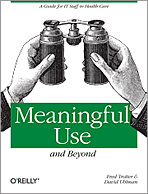 The Direct Project is all over HIMSS12, and really all over the country now. But it still carries controversy. When I found out that one of the Houston Health Information Exchange efforts had successfully launched a Direct Pilot, I simply had to do an interview. After all, here was software that I had contributed to as an open source project that was being deployed in my own backyard.
The Direct Project is all over HIMSS12, and really all over the country now. But it still carries controversy. When I found out that one of the Houston Health Information Exchange efforts had successfully launched a Direct Pilot, I simply had to do an interview. After all, here was software that I had contributed to as an open source project that was being deployed in my own backyard.
Jim Langabeer is the CEO of the newly renamed Greater Houston Healthconnect. I caught up with Jim at Starbucks and peppered him with questions about where Health Information Exchange (HIE) is going and what HIE looks like in Houston.
What’s your background?
Jim Langabeer: I have been in healthcare for a long time in the Texas Medical Center. I started as a hospital administrator at UTMB, where my first project was to work on an IT project team developing a Human Resources Management System. It was a collaborative effort between three hospitals.
I recently led a software company in the business intelligence space, which was later acquired by Oracle. After that, I decided I wanted to come back to Houston and continue to work in healthcare, so I returned to work for MD Anderson leading project and performance management. I eventually worked with the CIO Lynn Vogel to assess the business value of information systems. I most recently taught healthcare administration at the UT School of Public Health.
Throughout my healthcare career, I have been using data to drive healthcare decisions. My PhD is in decision sciences — quantitative modeling of data for decision-making — and my research grants have all involved analyzing large datasets to make healthcare decisions better. I have also worked between organizations in a collaborative manner. Health Information Exchange was an obvious next step for me.
Where are you in the process of creating a health information exchange?
Jim Langabeer: We are in the middle stage of operations. We are finalizing our architectural vision and choosing vendors. Most importantly, we have strong community support: 41% of the doctors in the region have committed to the exchange with letters of support as well as 61 of the 117 local hospitals.
We are meeting with all of the doctors we can. We are calling them and faxing them and visiting them, with one simple message: Health IT is coming and we want you to participate.
You mentioned an “architectural vision.” Can you expand on that?
Jim Langabeer: We really cannot have just one architecture, so our architectural vision really means choosing several protocols and architectures to support the various needs of our stakeholders in parallel. We need to accommodate the entire range of transactions that our physicians and hospitals perform. The numbers say that 50% of Houston docs work in small practices with only one or two doctors, and they typically do not have electronic health records (EHR). Hooking these doctors into a central hub model does not make sense, so a different model where they can use browser/view capabilities and direct connections between providers must be part of our architectural vision.
Houston also has several large hospitals using EPIC or other mature EHR systems. That means we need a range of solutions. Some docs just want to be able to share records. Some are more sophisticated and want to do full EHR linking. Some doctors just want to be able to view data on the exchange using a web portal.
We want to accommodate all of these requests. That means we want a portfolio of products and a flexible overall architectural vision. Practically, that means we will be supporting Direct, IHE and also older Hl7 v2.
Some people are saying Direct is all we want. We do not want a solution that is way over what small providers can handle and then it never gets used. We are architecture- and vendor-neutral, which can be difficult because EPIC is so prevalent in Houston.
We have practices that are still on paper on one hand and very sophisticated hospitals on the other, and that is just in the central Houston area. Immediately outside of Houston, lots of rural hospitals that we plan to support have older EHR systems or home-grown systems. That means we have to work with just about every potential health IT situation and still provide value.
Recently, a JAMIA perspectives article criticized Direct as a threat to non-profit HIE efforts like yours. Do you feel that Direct is a threat?
Jim Langabeer: I do not see Direct as a threat. I hear that from lots of sources, that Direct is a distraction for health information exchanges. I disagree.
I see it as another offering. The market is obviously responding to Direct. The price point on the software for Direct is definitely a benefit to smaller docs. We see it as a parallel path.
We do not see Surescripts (which is offering Direct email addresses to doctors with the AAFP) as a threat because we see them as a collaborator. We want them, and similar companies, to be part of our network. We are also having conversations with insurance companies and others who are not typically involved in health information exchanges because we are looking for partners.
The problem in healthcare is that it has always been very fragmented; no single solution gets much penetration. So, as we consider different protocols, we have to go with what people are asking for and what is already being adopted. We have to get to a point were these technologies have a very high penetration rate.
How are you narrowing your health IT vendors?
Jim Langabeer: What we want is a vendor that is going to be with us long term, sharing our risks and making sure we are successful. The sustainability of the vendor is connected to the sustainability of our exchange, so that is really important. Our 20-county region represents 6.4 million people, and that population is larger than most states that are pursing exchanges. Not many vendors have experience on that scale.
How important is the software licensing? Do open source vendors have an advantage?
Jim Langabeer: I am not sure they have an advantage. Of course, open source is ideal, but often proprietary vendors are ahead in terms of features. A mix in the long-term solution would be really cool.
How will you work with outside EHR vendors?
Jim Langabeer: We are trying to engage at the CIO level. We’re trying to understand what solutions standards and data they want to share. There is a core set of things everyone needs to do. Beyond that core, some people want to go with SOA; other people really want IHE or Direct. There is not much data sharing between hospitals. That is why industry standards are so important to us. It helps us shorten those discussions and make a more narrow offering. So, we are focusing on protocols as a means to work with the various EHR vendors.
One CIO told us, “We do not want to exchange data at all; we just want our doctors to be able to open a browser and see your data.” We may not like to hear that, but that is the reality for many organizations in Houston.
The other thing that is unique about Houston is that you are not going to see the state of Texas taking a dictatorial role. In other large exchanges, you often have a state-level government dictating HIE. In that environment, it is easier to insist on specific standards. That is not our situation in Houston, so we have to meet our constituents where they are.
I have been frustrated that the Direct Project reference implementations only come in Java and .NET at this point. I would like to see implementations in PHP, Python, Ruby, etc. — languages that are more popular with entrepreneurs. Are you concerned with issues like that?
Jim Langabeer: We’re definitely thinking about things like that. We do not want to be merely business-to-business — we want to offer services to consumers. So, we care about the technology becoming accessible to consumers, which means getting to iPhones. We want to be able to offer consumers tools that will bring them value, so we certainly care about issues like implementation language because we see those issues as connected.
If I let you dictate which Houston clinic or hospital I go to, when can I go see a doctor and get my patient data sent to my HealthVault or other PHR Direct account?
Jim Langabeer: I would hope that the technology would be ready by the end of year. What I envision is a core group of early adopters. We already have several hospitals and some physician groups that are interested in taking that role.
This interview was edited and condensed.
 Meaningful Use and Beyond: A Guide for IT Staff in Health Care — Meaningful Use underlies a major federal incentives program for medical offices and hospitals that pays doctors and clinicians to move to electronic health records (EHR). This book is a rosetta stone for the IT implementer who wants to help organizations harness EHR systems.
Meaningful Use and Beyond: A Guide for IT Staff in Health Care — Meaningful Use underlies a major federal incentives program for medical offices and hospitals that pays doctors and clinicians to move to electronic health records (EHR). This book is a rosetta stone for the IT implementer who wants to help organizations harness EHR systems.Related:
